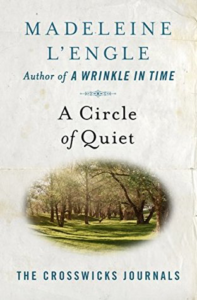
Memoirs come in many different forms. Some tell a chronological story, while others center around a theme. Some experiment with different structures. First published in 1972, this first in a series of memoirs by the author of A Wrinkle in Time and other beloved stories is more of a meditation, inviting us to explore with her, follow her thoughts, and see where they take us.
In the process, L’Engle gives us the kaleidoscope of her life at 51: spouse, parent, writer, teacher, choir director, member of communities large and small.
Many of her reflections are about writing in general, and specifically writing for children. She’s forthright about her years of rejections and how she felt about them. Invited to teach, she maintains that writing cannot be taught, but you can teach particular tools. Of course, she learns as much as she teaches, classroom discussions leading to new ideas.
She also defends children’s literature: its enduring appeal, its benefits for children and adults, and its literary quality.
L’Engle notes that “the concentration of a small child at play is analogous to the concentration of the artist of any discipline.” In those moments, we are not conscious of ourselves, not self-conscious. She goes on to say: “Detachment and involvement: The artist must have both. The link between them is compassion.”
At one point she says that “An author is responsible for his characters in much the same way that a parent is for his children, or a teacher for his students.” I think she means a moral responsibility, but it is still a concept that I’ve been turning over in my mind.
She speaks of her family’s years in New York City, and even more the years at Crosswicks, their rambling summer home in a small Connecticut town where at times four generations of her family live under one roof. There is much about community, and the peculiar interrelationship of people in such a small village, such as being suspicious of newcomers but still turning out to help them when they are in need.
Her portrait of the U.S. in the 1960s—the time period of this memoir—sometimes distracted me, sending my mind off into my own memories of those years. Hearing how someone the age of my parents viewed the happenings of that turbulent time sent me back to my own memories, turning them into new patterns.
She doesn’t shy away from the big subjects, such as faith, marriage, family, what might constitute a meaningful life. Still, it is her thoughts on writing that most resonate for me.
I am often, in my writing, great leaps ahead of where I am in my thinking, and my thinking has to work its way slowly up to what the “superconscious” has already shown me in a story or poem. Facing this does help to eradicate do-it-yourself hubris from an artist’s attitude towards his painting or music or writing. My characters pull me, push me, take me further than I want to go, fling open doors to rooms I don’t want to enter, throw me out into interstellar space, and all this long before my mind is ready for it.
The title comes from her need to retreat sometimes to her “circle of quiet,” a particular place at Crosswicks. We all need such a place, one where we can be our true selves. If you want a rest from the trauma Olympics of many memoirs on the market, try these reflections from a writer whose work you may know very well.
Do you have a “circle of quiet,” a place that is peculiarly your own?

Thanks for giving us L’Engle’s words: “Detachment and involvement: The artist must have both. The link between them is compassion.”–food for thought for me!